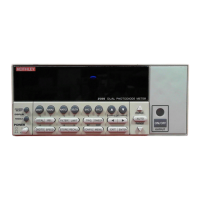Models 2500 and 2502 User’s Manual Data Store 8-5
Timestamp format
Buffer readings can be recalled using the absolute timestamp format or the delta format.
For the absolute format, readings are referenced to zero seconds. For the delta format, the
timestamp indicates the time between the displayed reading and the previous reading.
Perform the following steps to set the timestamp format:
1. While in the normal display mode, press CONFIG and then STORE to display the
timestamp choices.
2. Place the cursor on ABSOLUTE or DELTA and press ENTER.
Timestamp accuracy
Because of internal timing methods, the timestamp value is only approximate. The method
in which the timestamp is implemented limits its use in time-critical applications. If accu-
rate test timing is crucial, it is recommended that an external timer be used in conjunction
with the Model 2500.
The timestamp is based on an oscillator with a frequency of approximately 8kHz. This
oscillator is used as the system clock and is divided by eight to generate system “ticks”
every millisecond. Therefore, the timestamp should provide lms resolution for test timing.
However, since the actual oscillator frequency is 8.192kHz, a system tick occurs every
8.192kHz/8 or 1,024 times a second, which results in a system tick every 0.9765625ms.
As a result, the reported timestamp value is off by 24ms every second. Thus, to obtain
more accurate timestamp values, simply multiply the timestamp displayed on the front
panel or returned via remote by a factor of 0.9765625.
Buffer considerations
From the front panel, 3000 source and measure readings can be stored and accessed using
the method described earlier in this section. Over the bus, however, there are actually two
separate 3000 reading buffers for a total of 6000 readings. The :TRACe buffer is a 3000
reading buffer used by front panel data store, bus :TRACe commands, and to store sweep
data. The READ? buffer is a separate 3000 reading buffer that can only be accessed over
the bus using the :READ? command (or INIT;FETCh?). You can store and access data
from these two buffers separately as outlined below.
Using :TRACe commands to store data
Use :TRAC:POIN <n> and :TRIG:COUN <n> followed by :TRAC:FEED:CONT NEXT
to store data (n = number of readings; 3000 maximum). Use FORM:ELEM:TRAC
CURR1 | CURR2 to select the channel. Turn on the output with :OUTP1 ON or :OUTP2
ON and then send :INIT to take the unit out of idle and store readings. After data is stored,
send :TRAC:DATA? to access it. See Table 8-1 in this section for a summary of these
commands and Section 17, “TRACe subsystem,” for more details.
Test Equipment Depot - 800.517.8431 - 99 Washington Street Melrose, MA 02176
TestEquipmentDepot.com

